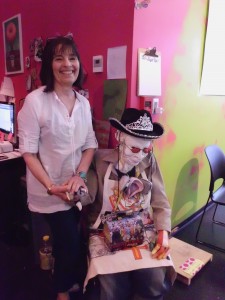In 1960s London the only purpose in women attending art school was to look good for the men.
At least, that is what Jann Haworth’s fellow art students said at the Slade School of Fine Art in London. Typical of a stubborn American artist, Haworth wouldn’t take “no” for an answer.
“For me it was a challenge and a sparring match,” Haworth said. “I was very lucky being a foreigner. I kind of was tolerated … in a way.”

Haworth did more than just survive in art school; she flourished. She showed her work at a senior showcase and was selected for short list to show at the Institute for Contemporary Art, which was the London’s premier art gallery at the time. There, she met Robert Fraser, a prestigious art dealer, who saw her work and offered to promote it.
From there, Haworth’s career as an artist took off. Jeff Lambson, the curator of contemporary art at the BYU Museum of Art, spoke about the influence Haworth had on pop art.
“In the ’60s she played a really important role in pop art; she was one of the pioneers of pop art,” Lambson said. “The role she played early on was very important. … She used unique soft materials and things in her art.”
The soft materials, fabrics and cloth, for example, were unprecedented at the time and caught the public’s attention. Some of her more famous works include the album cover of the Beatles, “Sgt. Pepper and the Lonely Hearts Club” and “Old Lady” and her other life-size dolls.
Haworth had an auspicious introduction into the art world. She came from an artistic background. Her mother came from a long line of scientists and engineers, but she turned to art as her outlet. When Haworth was a child, she was regaled with her mother’s tales from art school. She described herself as her “mom’s sounding board.”
Her father worked as one of the preeminent production designers in Hollywood. Haworth accompanied him to the sets of the shows and often saw stars like Marilyn Monroe working. Haworth was never very reverential of pop icons because of her childhood.
“For me, being around that, they were just grown-ups,” Haworth said. “I think I have always had a very healthy, ‘So what?'”
During his work, Haworth’s father worked on films such as “Some Like It Hot” and “Sayonara,” which he won a academy award for. Haworth saw her opportunity to take a break from school when her father was in France working on “The Longest Day,” and she decided to join him for a vacation. It was in France that Haworth first heard of the Slade School of Fine Art.
Today, Haworth’s work is shown in world-famous galleries in Paris, Italy and the United States, to name a few. However, Haworth has always known the priorities in her life, and her children remain more important than any world acclaim.
“I think your brain changes with your children,” Haworth said. “I have never looked back with sadness or nostalgia. I have never been a party-goer. It is not my natural element. Moving to the country (and away from the artist’s lifestyle) was wonderful.”
Haworth’s daughter, Liberty Blake, also pursued an art career and teaches with Haworth.
“She was amazing, a 100-percent-dedicated mum to us,” Blake said. “(She) put her own work to the side and prioritized us.”
Haworth didn’t rest on her artistic laurels when she took up motherhood. She eventually started a small school for her children when they didn’t want to go to the public schools, and she continued to work on her art whenever she could.
“I think the thing that I have always been constantly impressed by is her passion and energy for whatever she is doing,” Blake said. “She never says no. She is not inhibited or intimidated by anything; she throws herself into things with amazing passion and energy.”
Haworth moved to Utah in the late ’90s to continue her art here. She started another school at Sundance Resort called “Art Shack” and works at the Leonardo in Salt Lake City with her daughter, teaching and creating art.
Haworth isn’t done pushing barriers, however. She reported what a colleague told her recently.
“He said, ‘Your work is starting to sell now, because when you made it, people didn’t know how to take it,'” Haworth said. “That pleased me to no end.”
Now she is creating pieces reminiscent of her art in the ’60s but with the use of different materials. Haworth created a remake of the “Sgt. Pepper and the Lonely Hearts Club” album cover as a mural in Salt Lake City titled “SLC Pepper.” Her work in the Museum of Art’s exhibition “Work to Do,” also exemplifies her evolving perspective, utilizing simple lines and bold colors along with uncommon mediums like plastic.
“In a funny sort of way we are taking the things that are vagrant, those fleeting colors, and are extracting the color of the rock and making it permanent,” Haworth said. “I think that really anchors me.”




